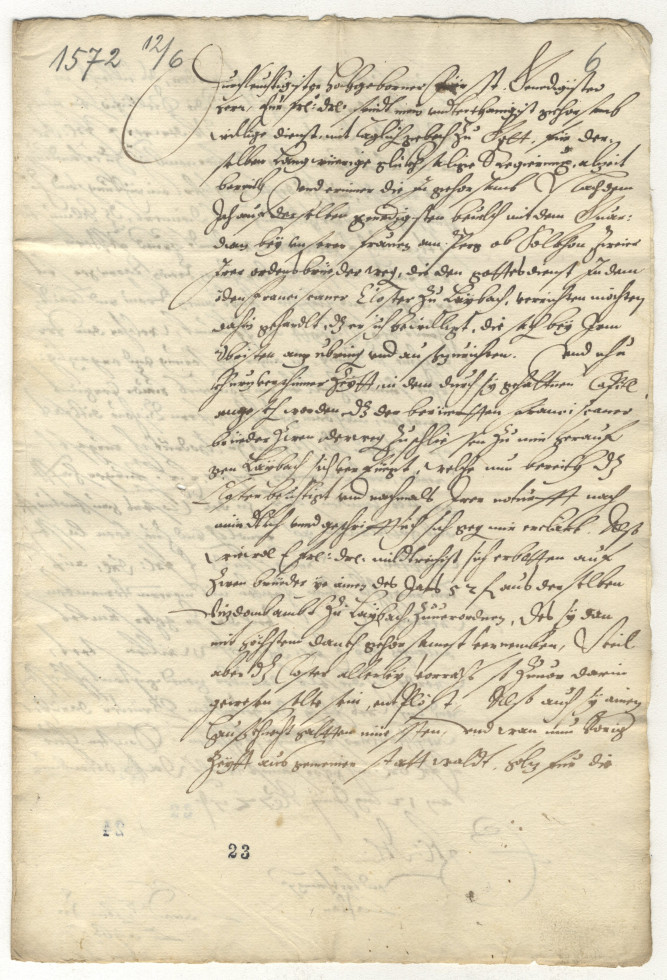Support Offered to Members of the Franciscan Order in Defence of Catholicism

A Letter Written by the Ljubljana Bishop Konrad Adam Glušič to Archduke Karl II, p. 1. | Author Arhiv Republike Slovenije
A Letter Written by the Ljubljana Bishop Konrad Adam Glušič to Archduke Karl II
Ever since the mid-13th century, the order of Friars Minor, which was founded by Francis of Assisi, had its own house in Ljubljana, located just east of the St. Nicholas Cathedral. Once the order was divided into Conventuals (known in the Habsburg lands as Minorites) and Observants (known as Franciscans), the Ljubljana brethren joined the Minorite branch. However, by the start of the 1490s, they were replaced in the Ljubljana house by the Franciscans, who settled there upon the request of King Maximilian and upon the mediation of the provincial governor Viljem of Auersperg. The house itself was included in the Austrian province with its seat in Vienna.
For the most part of the second half of the 16th century, Ljubljana was witnessing strong friction between Catholics and Protestants, or Lutherans to be exact. Prominent roles on the Catholic side were played out by the territorial prince, the Ljubljana bishop and members of Cathedral Chapter as well as by the members of the (catholic) religious orders, whereas Lutheran preachers found support in the majority of the Carniolan provincial estates and in the Ljubljana local authorities. The friction intensified in the second half of the 1550s, and more or less strongly continued well into the 1570s. One of the strong opponents of Protestantism in Ljubljana was a member of the Franciscan order and a preacher Jurij Bravšič, who even became the dean of the Ljubljana Cathedral Chapter in 1567.
Apart from Protestantism, Franciscan communities in the Austrian lands, in Croatia and in Hungary were also weakened by Turkish raids in the Western Balkans and in the Danube region, leading the Bosnian-Croatian province to ask the Austrian province for the Ljubljana house. The Austrian province, the General Minister and his Definitors actually agreed with the proposition, but the people of Ljubljana were against it. It is probably safe to assume that the Lutheran city authority in Ljubljana did not wish to see a number of new members of Franciscan order streaming into the city. Two years later, when only two Franciscan friars resided at the house in Ljubljana, the Ljubljana Magistrate appealed to the emperor to allow the moving of the city hospital into the almost empty Franciscan house. It was quite possible that after the Augustinians, who left Ljubljana five years earlier and whose monastery building at St. James’ Church then served as the imperial hospital, the capital of Carniola was to be abandoned by another religious community (Franciscans).
At the start of the 1570s, the conditions in the Ljubljana Franciscan house were apparently so serious, that even the territorial prince, his officials in Carniola and the Ljubljana Bishop Konrad Glušič became concerned. Several documents kept among the records of the archive of Vicedom for Carniola bear witness to their concern. First among these documents is the transcript of the letter written by Bishop Glušič in Gornji Grad on June 12, 1572 and addressed to Archduke Karl. In it, the bishop reports to the prince that upon his request two friars were sent to Ljubljana by the guardian of the Franciscan house in Sveta Gora near Gorizia. The two friars had a look at the Ljubljana house and made verbal and written commitment to move there. They gratefully accepted the financial support of 52 gulden paid to them annually by Vicedom upon the orders of the territorial prince. They also asked for the granting of wine and wheat tithe in Rijeka, which prior to that was enjoyed by brother Peter and after his death by the Bishop of Senj. The two Franciscan friars expressed concern that the annual support of 52 gulden was insufficient to meet all the needs of the house. We should point out here that at the time Franciscans did not manage the property of the house, which remained in the hands of the Lords of Auersperg, the attorneys and apostolic syndics for the cloister, who turned protestant.
Subsequent documents in relation to the above situation reveal that the territorial prince rejected the requests of the two Franciscans for the granting of the tithe in Rijeka, but the two friars nonetheless moved to Ljubljana and continued to receive annual support of 52 gulden for a number of years. The arrival of the two Franciscans from Sveta Gora to Ljubljana actually led to the take-over of the house in Ljubljana by the brethren of the Bosnian-Croatian province. Although the Austrian province exercised its right to the Ljubljana house at the start of the 17th century, it was decided by the General Minister and his Definitors in 1615 to turn the house over to the Bosnian-Croatian province. The province added the name of Carniola to its official title, and in the second half of the 17th century the cloister in Ljubljana became its centre and the house of Provincial Minister.
Jože Škofljanec
